This article does not cite any sources .(January 2008) (Learn how and when to remove this template message) |
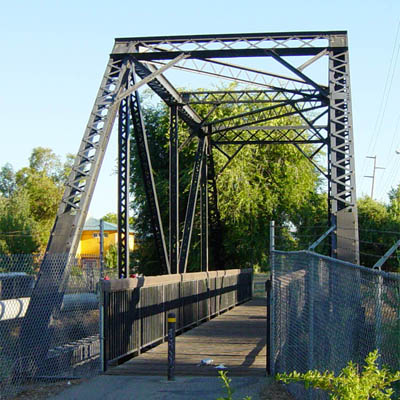
A box truss is a structure composed of three or more chords connected by transverse and/or diagonal structural elements.
This article does not cite any sources .(January 2008) (Learn how and when to remove this template message) |

A box truss is a structure composed of three or more chords connected by transverse and/or diagonal structural elements.
Box trusses are commonly used in certain types of aircraft fuselages, electric power pylons, large radio antennas, and many bridge structures. (For various truss arrangements used see truss bridge.)
By using what are in effect stiff panels in a cylindrical arrangement the resulting structure can have a high resistance to axial torsion (twisting along its long axis) and a higher resistance to buckling in its highly loaded sides.
When finished as an open structure the truss will be less subject to wind drag and to aeroelastic effects than would a completely enclosed structure.
| This engineering-related article is a stub. You can help Wikipedia by expanding it. |
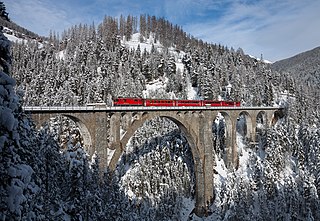
A bridge is a structure built to span a physical obstacle, such as a body of water, valley, or road, without closing the way underneath. It is constructed for the purpose of providing passage over the obstacle, usually something that can be detrimental to cross otherwise. There are many different designs that each serve a particular purpose and apply to different situations. Designs of bridges vary depending on the function of the bridge, the nature of the terrain where the bridge is constructed and anchored, the material used to make it, and the funds available to build it.
Lattice may refer to:

A covered bridge is a timber-truss bridge with a roof, decking, and siding, which in most covered bridges create an almost complete enclosure. The purpose of the covering is to protect the wooden structural members from the weather. Uncovered wooden bridges typically have a lifespan of only 20 years because of the effects of rain and sun, but a covered bridge could last 100 years.

A truss is an assembly of beams or other elements that creates a rigid structure. In engineering, a truss is a structure that "consists of two-force members only, where the members are organized so that the assemblage as a whole behaves as a single object". A "two-force member" is a structural component where force is applied to only two points. Although this rigorous definition allows the members to have any shape connected in any stable configuration, trusses typically comprise five or more triangular units constructed with straight members whose ends are connected at joints referred to as nodes.
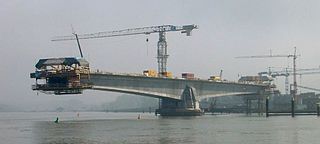
A cantilever bridge is a bridge built using cantilevers, structures that project horizontally into space, supported on only one end. For small footbridges, the cantilevers may be simple beams; however, large cantilever bridges designed to handle road or rail traffic use trusses built from structural steel, or box girders built from prestressed concrete. The steel truss cantilever bridge was a major engineering breakthrough when first put into practice, as it can span distances of over 1,500 feet (460 m), and can be more easily constructed at difficult crossings by virtue of using little or no falsework.

A truss bridge is a bridge whose load-bearing superstructure is composed of a truss, a structure of connected elements usually forming triangular units. The connected elements may be stressed from tension, compression, or sometimes both in response to dynamic loads. The basic types of truss bridges shown in this article have simple designs which could be easily analyzed by 19th and early 20th-century engineers. A truss bridge is economical to construct because it uses materials efficiently.

Beam bridges, also known as stringer bridges, are the simplest structural forms for bridge spans supported by an abutment or pier at each end. No moments are transferred throughout the support, hence their structural type is known as simply supported.
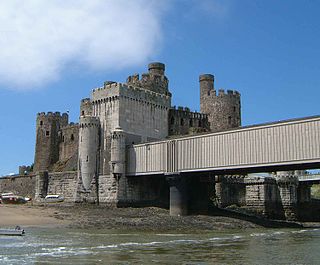
A tubular bridge is a bridge built as a rigid box girder section within which the traffic is carried. Famous examples include the original Britannia Bridge over the Menai Strait, the Conwy railway bridge over the River Conwy, designed and tested by William Fairbairn and built by Robert Stephenson between 1846 and 1850, and the original Victoria Bridge in Montreal.

A girder is a support beam used in construction. It is the main horizontal support of a structure which supports smaller beams. Girders often have an I-beam cross section composed of two load-bearing flanges separated by a stabilizing web, but may also have a box shape, Z shape, or other forms. A girder is commonly used to build bridges.

A girder bridge is a bridge that uses girders as the means of supporting its deck. The two most common types of modern steel girder bridges are plate and box.
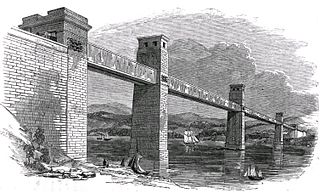
A box or tubular girder is a girder that forms an enclosed tube with multiple walls, as opposed to an I- or H-beam. Originally constructed of riveted wrought iron, they are now made of rolled or welded steel, aluminium extrusions or prestressed concrete.

Whites Bridge is a 120-foot span Brown truss covered bridge, originally erected in 1869 in Keene Township, Michigan, United States, near Smyrna on the Flat River. Carrying Whites Bridge Road across the Flat River, it is located north of the Fallasburg Bridge and south of Smyrna. The original bridge was among the area's best-known 19th century structures. The bridge was completely destroyed by fire, on the morning of July 7, 2013. In July, 2016, approval was granted for rebuilding a replica bridge, which was completed in April, 2020.
A Brown truss is a type of bridge truss, used in covered bridges. It is noted for its economical use of materials and is named after the inventor, Josiah Brown Jr., of Buffalo, New York, who patented it July 7, 1857, as US patent 17,722.

Blackfriars Bridge in London, Ontario, Canada is a wrought iron bowstring arch through truss bridge, crossing the North Thames River. The bridge was constructed in 1875 and carries single-lane vehicles, bicycles and pedestrians from Blackfriars Street to Ridout Street North.

A deck is the surface of a bridge. A structural element of its superstructure, it may be constructed of concrete, steel, open grating, or wood. Sometimes the deck is covered a railroad bed and track, asphalt concrete, or other form of pavement for ease of vehicle crossing. A concrete deck may be an integral part of the bridge structure or it may be supported with I-beams or steel girders.
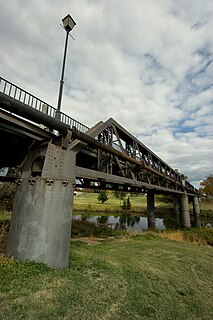
The Denison Bridge is a heritage-listed footbridge over the Macquarie River in Bathurst, New South Wales, Australia. It is the fourth oldest metal truss bridge existing in Australia.

The Bethanga Bridge is a steel truss road bridge that carries the Riverina Highway across Lake Hume, an artificial lake on the Murray River in Australia. The dual heritage-listed bridge crosses the border between the Australian states of New South Wales and Victoria, linking the Victorian towns of Bellbridge and Bethanga with the regional New South Wales city of Albury.

Old Cobram-Barooga Bridge is a heritage-listed former road bridge and now footbridge over the Murray River at Barooga-Cobram Road, Barooga, Berrigan Shire, New South Wales, Australia. The bridge links Barooga with Cobram, its sister town in Victoria. It was designed by Ernest de Burgh (engineer) and the New South Wales Department of Public Works and built from 1900 to 1902. It is also known as RMS Bridge No 3247. The property is owned by Roads and Maritime Services. It was added to the New South Wales State Heritage Register on 1 April 2016.

The Karuah River bridge is a heritage-listed road bridge that carries the Weismantels-Dingadee Road across the Karuah River, located at Monkerai in the Mid-Coast Council local government area of New South Wales, Australia. The bridge is also known as the Monkerai Bridge over Karuah River. The bridge is owned by Roads and Maritime Services, an agency of the Government of New South Wales. It was added to the New South Wales State Heritage Register on 20 June 2000.

Emu Plains Underbridge is a heritage-listed steel truss railway underbridge located off Bruce Neale Dr approximately 1.3 kilometres (0.81 mi) west of the Penrith railway station in the western Sydney suburb of Penrith in the City of Penrith local government area of New South Wales, Australia. It was designed by James Fraser, the existing lines branch and the New South Wales Government Railways. It was built in 1907, with fabrication by R. Tulloch & Co.; and erection by day labour. It is also known as Emu Plains Underbridge and Penrith Underbridge. The property is owned by RailCorp, an agency of the Government of New South Wales. It was added to the New South Wales State Heritage Register on 28 June 2013.